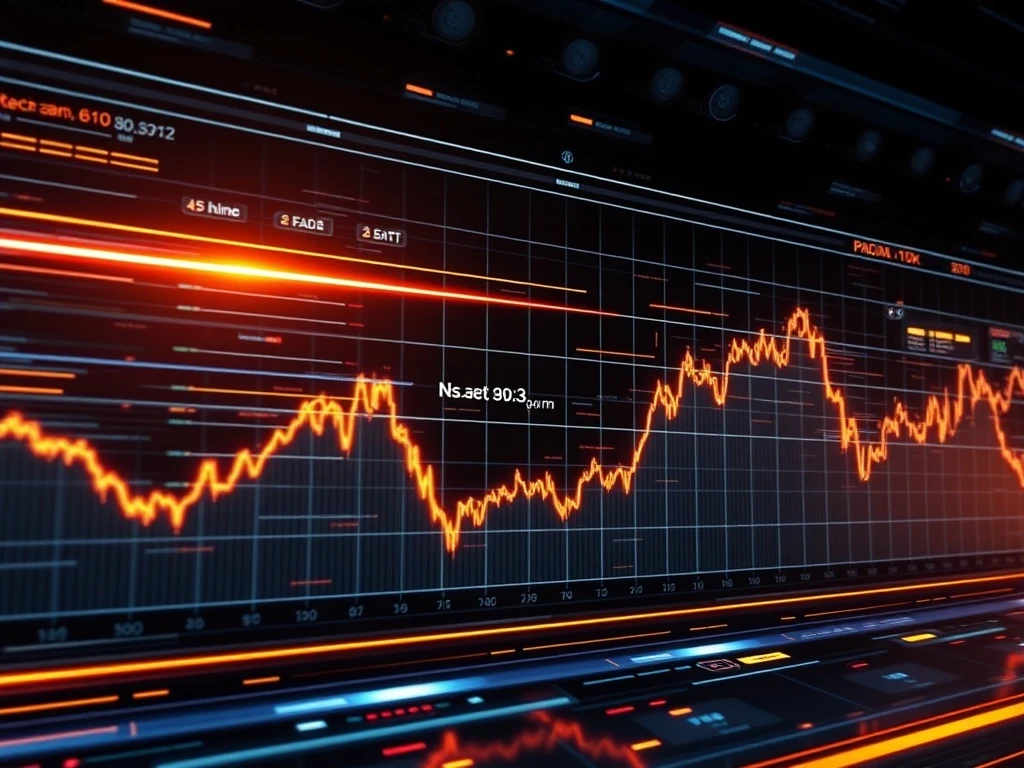Hyperliquid DEX: Unveiling the Explosive 300% HYPE Token Surge

In the fast-paced world of cryptocurrency, few stories capture attention quite like a meteoric rise. The HYPE token, powering the innovative Hyperliquid DEX, has seen its value skyrocket by over 300% in just two months. This impressive surge has ignited a crucial debate: Is this growth sustainable, or are we witnessing another fleeting moment of ‘hype’ in the crypto market? Let’s dive deep into the fundamentals, the market dynamics, and the inherent risks to understand if Hyperliquid’s ascent is truly justified.
Hyperliquid DEX: A New Frontier in Decentralized Trading
Launched in 2023 by Harvard alumni Jeff Yan and Iliensinc, Hyperliquid emerged with an ambitious vision: to combine the transparency and self-custody of a Decentralized Exchange with the speed and efficiency typically found on centralized platforms. What sets the Hyperliquid DEX apart in a crowded market?
- Unparalleled Speed: The platform claims to support up to 200,000 transactions per second (TPS), a figure that rivals traditional financial systems. This is achieved through its custom layer-1 blockchain, built on a variant of Byzantine Fault Tolerance (BFT) consensus called HyperBFT.
- Streamlined User Experience: Hyperliquid offers features like one-click trading, direct deposits from over 30 different blockchain networks, and access to spot, margin, and Perpetual Futures markets. This focus on user convenience aims to bridge the gap between complex DeFi interfaces and the simplicity of centralized exchanges.
- Innovative Asset Handling: Rather than requiring users to bridge actual tokens, Hyperliquid facilitates trading through perpetual contracts tied to token prices. While this design significantly boosts efficiency and reduces friction, it does introduce a reliance on accurate price oracles and robust funding rate mechanisms.
The numbers underscore Hyperliquid’s growing influence. According to DefiLlama, the platform now ranks 8th among all blockchains by Total Value Locked (TVL), holding an impressive $1.75 billion. Its flagship decentralized exchange product consistently clears over $420 million in daily trading volume, positioning it among the top decentralized exchanges globally. The platform reached a critical inflection point in November 2024, experiencing a tenfold jump in daily trading volume, from $2 billion to over $20 billion, and now boasts more than 500,000 users.
The HYPE Token’s Meteoric Rise: What’s Driving It?
Since its local bottom in April, the HYPE token has surged by over 300% in just two months, reaching an all-time high on June 17 before a slight correction. This explosive growth is not just speculative; it’s underpinned by a robust design and strategic tokenomics.
The HYPE token serves as both the gas token and governance asset for the Hyperliquid chain. Holders can stake HYPE directly on the platform or through validation, contributing to network security and participating in its future direction. A significant driver of value is Hyperliquid’s commitment to its token holders: roughly 97% of protocol fee revenue is reinvested into HYPE buybacks through its Assistance Fund, which has amassed $910 million in HYPE over the past six months. This mechanism directly aligns the token’s value with the platform’s operational success.
Furthermore, the supply of HYPE is meticulously managed. Of the total supply of 1 billion tokens, only about 34% is currently in circulation. A substantial portion of the team’s tokens (23.8% of the total supply) is vested until 2027-2028, signaling a long-term commitment. Additionally, almost 39% of the total supply is earmarked for ‘community rewards’ to be distributed gradually, fostering ongoing engagement and growth. Notably, the project launched without external venture capital funding, meaning there’s no immediate pressure from early investors to offload tokens, which can often depress prices in other projects.
Adding to the momentum, Nasdaq-listed Lion Group recently announced its intention to hold $600 million in reserves with HYPE as its primary treasury asset. Such institutional adoption provides a strong vote of confidence and brings significant capital into the ecosystem, further fueling investor interest in the HYPE token.
Navigating the Decentralized Exchange Landscape
Hyperliquid’s rise has reshaped the Decentralized Exchange landscape, particularly within the perpetuals market. The platform now commands an impressive 70% of all decentralized perpetuals trading volume, a clear indicator of its dominance in this niche. However, this leadership in DeFi still represents a fraction of the broader crypto trading market. For instance, Hyperliquid’s volumes currently stand at only about 10% of Binance’s global volumes.
This comparison highlights both a massive upside potential and a fundamental challenge. While there’s significant room to grow by attracting users from centralized exchanges, particularly if the regulatory climate for crypto improves globally, Hyperliquid’s design choices also invite scrutiny. The platform’s high throughput, while a major benefit, comes at the cost of decentralization. With just 21 delegated validators, the network’s resilience and censorship resistance are less robust compared to networks like Ethereum, which boasts over 14,200 execution-layer nodes.
This trade-off between performance and decentralization is a recurring theme in blockchain innovation. While speed and convenience attract users, the principle of decentralization is designed for resilience, especially when market conditions become volatile or regulatory pressures mount. As the saying goes, centralization risk rarely matters—until it suddenly does.
Decentralization vs. Performance: A Quick Comparison
Understanding the balance Hyperliquid strikes is crucial for assessing its long-term viability:
| Feature | Hyperliquid (HyperBFT L1) | Ethereum (PoS L1) |
|---|---|---|
| Validator Count | 21 (Delegated) | ~14,200 (Execution Layer Nodes) |
| Claimed TPS | Up to 200,000 | ~15-30 (L1), Higher with L2s |
| Consensus Mechanism | HyperBFT (variant of BFT) | Proof-of-Stake |
Perpetual Futures: The Engine of Hyperliquid’s Growth
The core of Hyperliquid’s success lies in its focus on Perpetual Futures. These are a type of derivative contract that allows traders to speculate on the future price of an asset without an expiration date. Unlike traditional futures, perpetuals aim to mimic the spot price through a funding rate mechanism, making them highly popular in the crypto space for their flexibility and leverage opportunities.
Hyperliquid has optimized its platform specifically for this high-volume, high-frequency trading environment. The ability to execute trades quickly, with minimal slippage and direct deposits from numerous chains, makes it an attractive venue for derivatives traders. The significant jump in daily trading volume observed in November 2024, from $2 billion to over $20 billion, directly correlates with the growing adoption and demand for decentralized perpetuals, a market Hyperliquid has decisively captured.
This specialization allows Hyperliquid to cater to a specific, highly active segment of the crypto market. By providing a superior experience for Perpetual Futures trading on a decentralized platform, it has carved out a dominant position, attracting professional traders and institutional players alike.
Decoding the Crypto Valuation Debate: Is HYPE Sustainable?
Despite its impressive performance and market leadership, the Crypto Valuation of HYPE remains a contentious point. With a current market cap of $12.4 billion and a fully diluted valuation (FDV) of around $38 billion (some estimates even reaching $50 billion), questions about its sustainability are valid.
Simon Dedic, CEO of Moonrock Capital, voiced his skepticism on X, stating, “I love Hyperliquid… But seriously – who’s buying HYPE at nearly $50B [of fully diluted valuation]? How is the risk/reward ratio still even remotely reasonable here?” This sentiment reflects a common concern among investors when a token’s valuation seems to outpace traditional metrics.
However, proponents, including crypto analyst Ansem, offer counter-arguments. They suggest that focusing solely on high valuation overlooks several critical factors:
- Market Share Dominance: Hyperliquid commands 70% of all decentralized perpetuals trading. This leadership position suggests strong product-market fit and a robust user base.
- Growth Potential: The gap between Hyperliquid’s volumes and those of centralized giants like Binance (Hyperliquid is currently 10% of Binance’s global volumes) represents a massive potential for future growth, especially if regulatory environments become more favorable to decentralized platforms.
- Unique Tokenomics: The 97% fee revenue reinvestment into HYPE buybacks, coupled with long vesting schedules for team tokens and significant allocations for community rewards, creates a powerful incentive structure for long-term holding and platform growth. The absence of early VC funding also removes a typical source of sell pressure.
From this perspective, the high fully diluted valuation, while notable, might not be irrational for long-term holders who believe in the protocol’s trajectory and its potential to capture a larger share of the global derivatives market. Current buyers are speculated to include late-stage venture capitalists seeking exposure to a dominant player, traditional finance analysts applying new valuation models to crypto assets, and large ETH or SOL whales rotating capital into what they perceive as the next dominant trading layer.
Conclusion: A Calculated Ascent or a Risky Bet?
The Hyperliquid DEX and its surging HYPE token present a compelling case study in the evolving world of decentralized finance. Its innovative approach to high-performance trading, coupled with strategic tokenomics and growing institutional interest, positions it as a significant player in the Perpetual Futures market. The platform’s ability to attract substantial trading volume and user adoption speaks volumes about its product quality and market fit.
However, the rapid Crypto Valuation and the inherent trade-off between speed and decentralization pose valid questions about its long-term sustainability and resilience. While Hyperliquid has clearly captured a dominant share of the decentralized derivatives market, its path forward will depend on its ability to navigate regulatory landscapes, maintain technological edge, and address the fundamental concerns surrounding its validator count.
For investors and users alike, Hyperliquid represents both an exciting opportunity and a reminder of the dynamic risks within the crypto space. Its journey underscores the constant tension between innovation, efficiency, and the foundational principles of decentralization. As Hyperliquid continues to grow, the crypto community will be watching closely to see if its explosive ‘hype’ is indeed justified by enduring value.









